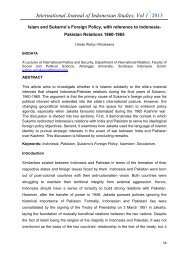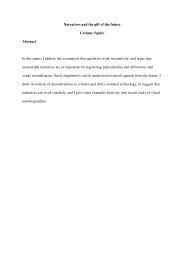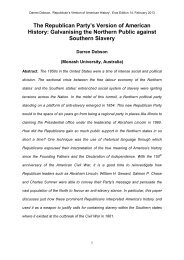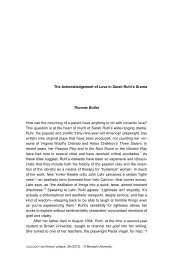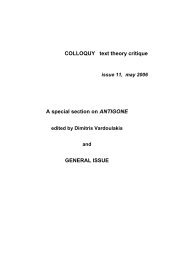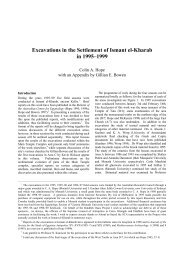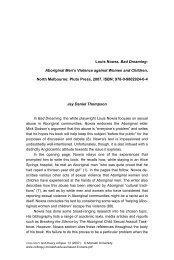Performative Pastiche: Judith Butler and Gender Subversion
Performative Pastiche: Judith Butler and Gender Subversion
Performative Pastiche: Judith Butler and Gender Subversion
- No tags were found...
You also want an ePaper? Increase the reach of your titles
YUMPU automatically turns print PDFs into web optimized ePapers that Google loves.
Pettitt - Issue three - Colloquy<strong>Performative</strong> <strong>Pastiche</strong>: <strong>Judith</strong> <strong>Butler</strong> <strong>and</strong> <strong>Gender</strong> <strong>Subversion</strong>Annie PettittIt makes no difference if you're black or white,If you're a boy or a girl,If the music's pumpin' it'll give you the night,You're a superstar, that's what you are.Madonna, 'Vogue'."What is a real woman or a real man? Were we all just playing at gender." Jennie Livingston, cited inWeekend Australian 18-19 April 1992.Does it really make no difference if you're black or white, boy or girl, male or female? Is it the dance orperformance itself that produces the body, the identity? <strong>Judith</strong> <strong>Butler</strong> argues that gender is aperformative citation, a reiteration of an always already derived identity that takes place within aneconomy of heterosexuality.[1] So what happens when a body performs the so-called 'wrong' gender?Can we think of this as a subversive action in <strong>and</strong> of itself? To do so <strong>Butler</strong> argues would assume, firstly,that the performer has the ability <strong>and</strong> agency to consciously choose his/her own gender <strong>and</strong>, secondly,that the performance somehow takes place outside of the juridical regime that constrains <strong>and</strong> bounds itsconstituents. Central to <strong>Butler</strong>'s thesis is that agency is affective; that is to say, agency can only beeffected from a gendered position, therefore the subject does not exist prior to its agency, rather isconstituted as the very affect of agency. Despite appearances these presuppositions are not counter to,but rather primary to <strong>Butler</strong>'s reading [2] of gender <strong>and</strong> subversion. So when is drag subversive <strong>and</strong>when is it the reinstatement of hegemonic norms? In <strong>Gender</strong> Trouble <strong>Butler</strong> argues that drag is"potentially" subversive; but on what grounds does she assert this? And why is it that when she is laterforced to clarify her position in response to misreadings, she states that drag is not necessarilysubversive?This paper is an attempt to investigate what is at stake in the performance of gender <strong>and</strong> where thepossibilities for, <strong>and</strong> limits of, subversive action lie. In discussing what gets to count as subversive, <strong>and</strong>for whom, issues of complicity <strong>and</strong> voluntarism will be addressed. Further, in an effort to explore theintricacies of <strong>Butler</strong>'s thesis of gender identity as performative, it will be argued that despite theuncertainty of whether drag is or is not subversive in <strong>and</strong> of itself, it does nonetheless call into questionthe 'natural' <strong>and</strong> 'original' status of identities in general within phallogocentrism. To disturb the formalpresence of identity in this way will leave open the possibility for further questioning of what constitutesidentity, what gets to count as valuable within a phallogocentric economy, <strong>and</strong> consequently how notionsof identity may be re-figured. It is at the nexus of gender performativity - demonstrated in the drag ballsdocumented in Paris is Burning (1990) - that the gender categories that normative heterosexualityrequires us to perform, are themselves revealed to be nothing other than re-citations that areinterminably deferred, without recourse to an original form.Throughout this paper Jennie Livingston's documentary film Paris is Burning will be taken as an exampleof a potentially subversive performance, but it must be stated at the outset (as <strong>Butler</strong> herself has donemany times) that it must not be taken to be paradigmatic of all subversive acts; it is merely one possibleexample among others. In her production of Paris is Burning Livingston takes the drag balls of Harlem<strong>and</strong> their "walkers"[3] to a new audience - the outside, or real (read heterosexual white) world - to bejudged again. But there is no guarantee that they will be evaluated on the same criteria in this 'real'world. Given that "Realness" itself is a major st<strong>and</strong>ard by which the contestants are judged at theseballs, we might wonder how this realness is to be ascertained in this so-called 'real' world. It would seemfrom the description of Realness as "the ability to pass as something you are not, as in poor for rich,male for female, gay for straight", [4] that its performance is in fact reducible to a more real realness -implied in the "something you are not". If what constitutes drag as potentially subversive is theperformance of Realness, we might then ask to what extent subversion is dependant on its reception, itsaudience, that is to say its recognition as subversive. If there can be no guarantee that one's subversiveintentions will result in insurrection, as is the case with the st<strong>and</strong>ard of Realness in Paris is Burning, howthen does a parody of gender subvert hegemonic norms if the very st<strong>and</strong>ard by which it is judged is theability to produce a 'natural,' a 'real' effect? Perhaps we could say that drag is doubly subversive; it
denaturalises normative notions of "sex" <strong>and</strong> "sexuality" <strong>and</strong> their relationship to gender, whilst alsonaturalising them. In other words, the performance of drag might be understood to put into question thenormative assumption within the heterosexual hegemony that prescribes the performance or 'being' offemininity to a 'real' female body who must desire a male body inscribed with masculinity <strong>and</strong> vice versa.[5] In drag the performance of femininity by a male body or masculinity by a female body demonstratesthe mutability of gender. Furthermore, it testifies to the arbitrary relation between sex <strong>and</strong> gender; sexcan therefore no longer be simply understood as that raw material upon which gender is later inscribed.In Paris is Burning this relationship between the destabilisation of normative sex/uality <strong>and</strong> itsreinstatement is confounded by the very structure of kinship that governs not only the drag balls but alsothe "off stage" lives of all those involved. This is a consanguinity that appears to fundamentally reflectthe primary structure of private life under patriarchy, that is, the nuclear family. When competitors or"kids" walk they represent not only themselves but their "families", they rely on one another for support<strong>and</strong> guidance, but most especially upon the support of their "Mothers." The "Mother" is the leader <strong>and</strong>often the founder of the "House", she is "wise <strong>and</strong> compassionate ... [<strong>and</strong>] acts as a surrogate parent"[6]to the "Children" of her "House". These "Houses" then, are not only what Foucault calls the "numberlessfamily of perverts," [7] they have also actively adopted a certain notion of kinship that is fundamentallyinscribed in the hegemonic discourses of patriarchy, <strong>and</strong> therefore re-inscribes them in the verydiscourse they are opposed to. As Peggy Phelan states, "The children of Paris accept the structure ofthe Freudian narrative, in much the same way they accept the operative power of whiteness, mimic it,<strong>and</strong> in that mimicry transform its defining power."[8] But if this mimicry falls back into a reinforcement ofthe very norms that it seeks to destabilise, how are we to maintain a view of drag as subversive?It is <strong>Butler</strong>'s contention that, if we are to develop our underst<strong>and</strong>ing of the movements of subversion, wemust first consider the consequences of this necessary 'outside' that is actually 'inside'. It has beenasserted by some feminist theorists following on from psychoanalytic discourses, that the material bodyitself is that which is unrepresentable within language. [9] The body is always in excess of discourse;<strong>Butler</strong> argues however, that this notion of the body is not a radical outside; rather, it is the constitutiveground upon which the law is founded, through the mediation of language. Thus the 'outside' must beread as 'inside'. If this notion of the body is the enabling 'outside' that is in fact 'inside' the law, how can itsubvert the very structures from which it is formed? At this point let us turn to <strong>Butler</strong>'s description of the'abject' in <strong>Gender</strong> Trouble as that which has been expelled from the body <strong>and</strong> thence rendered "Other".She solicits the work of Julia Kristeva who says in illustrating abjection: "I expel myself, I spit myself out, Iabject myself within the same motion through which "I" claim to establish myself." [10] There is acorrelation here between this bodily abjection described by Kristeva <strong>and</strong> what might be called a juridicalabjection, that is, an expelling of that which is not normative - i.e. white, male <strong>and</strong> heterosexual. This isan othering that is itself the condition for the production of a normative subjectivity. Along this trajectory itbecomes immediately clear that the very discussion of Subject/Object relations is conditioned by, <strong>and</strong>also the constitutive condition of, the qu<strong>and</strong>ary of identity that it seeks to resolve. For <strong>Butler</strong> then, thisnecessary outside - the abject - is not an absolute outside but rather an outside constructed in order thatthe inside is able to assert its own identity as natural, original <strong>and</strong> unified. Once this production isdeferred ad infinitum, <strong>and</strong> its genesis is rendered irretrievable, the process of naturalisation is complete.Or is it?In her discussion of Paris is Burning,[11] <strong>Butler</strong> seems to have developed a certain appreciation for whatis at stake in the subversive act. She asks whether the "denaturalisation" of gender in <strong>and</strong> through theperformance of drag is not itself a vehicle by which the norms of hegemonic discourses are actuallyreconsolidated.[12] In her earlier work it is clear that <strong>Butler</strong> sees drag as a potentially subversive parodyof the hegemonic norms that surround "sex" <strong>and</strong> "sexuality." Parody here is understood as an imitationwith the intention to mimic <strong>and</strong> perform the notion of an original, differently. Through its parodicperformance, which avows the distinction between the anatomical sex of the performer <strong>and</strong> the genderperformed, drag dramatises <strong>and</strong> destabilises the fabricated unity of sex <strong>and</strong> gender, as it is constructedwithin the heterosexual hegemony. [13] It is by way of this convoluted relationship between "original" <strong>and</strong>"imitation," between cause <strong>and</strong> effect, that drag poses a challenge not only to the production of "sex" asprior to the imposition of a law governed by masculinity <strong>and</strong> heterosexuality, <strong>and</strong> "gender" as theinscription of "sexuality" on that already sexed body; it also opens up the discussion of the ontology ofsubjectivity <strong>and</strong> identity in general.These complexities surrounding the production of (sexed) subjectivity are dealt with in finer detail in<strong>Butler</strong>'s later work. In this instance she qualifies what was said in <strong>Gender</strong> Trouble <strong>and</strong> draws attention tothe ambivalent character of drag, as a reflection of one's general implication in regimes of power through
<strong>and</strong> by which one is constituted - <strong>and</strong> thus in the regimes to which one might be opposed. In saying thatdrag <strong>and</strong> subversion are not necessarily related, <strong>and</strong> that the performance of drag may be utilised tore-idealise the concepts of normative heterosexuality, she offers a more profound underst<strong>and</strong>ing of theintricacies of drag <strong>and</strong> the debate surrounding "sex," "sexuality," bodies <strong>and</strong> subjectivity. Theheterosexual economy sustains its privilege in various ways, but its two central modes of operation are itsown "naturalisation" <strong>and</strong> "origination." To complicate matters further, even where the lack of naturalness<strong>and</strong> origin are acknowledged, the power of heterosexuality can be retained <strong>and</strong> even reinforced. Here<strong>Butler</strong> points to the demonstration of "high het entertainment" expressed in films such as Victor, Victoria;Tootsie; <strong>and</strong> Some Like it Hot, all of which frame <strong>and</strong> maintain an implicit homophobia.[14]In problematising when <strong>and</strong> in what context an act gets to count as subversive, <strong>Butler</strong> leaves us in aqu<strong>and</strong>ary of how exactly we might define the condition for the possibility of subversion. If one cannot"plan or calculate subversion" <strong>and</strong> any attempt is always "potentially recuperable",[15] what is left ofagency? How is one to move beyond the limits of power if one is always already limited by it? It is thisparadox to which <strong>Butler</strong> speaks when she states that "there can be no pure opposition to power, only arecrafting of its terms from resources invariably impure".[16] In spite of this paradox within which onemust work, the key seems to lie in the reading , the challenge to conventional ways of reading.Subversive practices must be legible, <strong>Butler</strong> says, <strong>and</strong> yet they must overwhelm <strong>and</strong> exceed the capacityto read. This is how the possibilities for 'new' readings will emerge. The potentially subversive act isalways recuperable for the very reason that it is always a re-citation, for it must be legible in order to beapprehended as subversive.Although there is no guarantee of subversion, this does not preclude us from an investigation into theenabling condition for the possibility of subversion. Throughout her work <strong>Butler</strong> seeks to destabilise asystem that purports to be founded on its own solid grounds. She does this by revealing that thesegrounds are themselves fundamentally reliant upon that which they have expelled <strong>and</strong> rendered other.That which is believed to be 'outside' is in fact inside, <strong>and</strong> must be read as a 'constitutive outside' <strong>and</strong>therefore the enabling condition of that system - that is, the heterosexual hegemony. It is through asimilar movement that the possibility for subversion is discussed. The possibility of subversion is enabledby its own legibility, a legibility that, as already stated, allows for its simultaneous recuperation.Such a notion of reading <strong>and</strong> legibility binds subversion to the moment of re-citation. <strong>Butler</strong>'s argument isthat if sex <strong>and</strong> sexuality are understood as performative re-citations, which are always already spoken for- always already inscribed in our bodies - then it is within this reiteration that the possibility for subversionlies. Further she states that, "Insofar as performatives are their own referent , they appear both to signify<strong>and</strong> to refer <strong>and</strong> hence to overcome the divide between referent <strong>and</strong> signification that is produced <strong>and</strong>sustained at the level of foreclosure".[17] It is in this ability to both signify <strong>and</strong> (re)produce themselvesthat performatives are potentially subversive, for they destabilise the radical incommensurability betweenthe 'real' (that which resists representation) <strong>and</strong> symbolisation. In its resistance to symbolisation, <strong>Butler</strong>suggests that, the 'real' has an exterior relationship to language, <strong>and</strong> is therefore the site at which allrepresentations collapse. [18] <strong>Butler</strong>'s notion of the body is itself in excess of representation. It could beargued then, that for <strong>Butler</strong>, it is the material body is exactly that site of excess, which is 'real.'This incommensurable gap between real <strong>and</strong> representation <strong>Butler</strong> notes is illusory, since the statement:"the real resists symbolisation" is itself a symbolisation, thus rendering that statement untrue. Such adeconstructive mode of inquiry reveals the holes in social systems <strong>and</strong> epistemological structures thatpurport to be water-tight, <strong>and</strong> in so doing opens the way for subversive possibility. This is not aconfrontational attack on those structures; for, as <strong>Butler</strong> has shown, such action must certainly lead totheir reinforcement. Rather, effective subversion lies in the destabilisation of specific terms, such as "sex"<strong>and</strong> "race", that have been produced <strong>and</strong> constrained by oppressive regimes of ("sexist" <strong>and</strong> "racist")power. These terms are not simply to be disposed of, they must play the game - at least partially - <strong>and</strong>be repeated; only this time in a direction that reverses <strong>and</strong> displaces their originating <strong>and</strong> originary aims.[19] In other words, we must re-cite in a manner of parody <strong>and</strong> mimicry, a practice that will destabilise thevery authority of such terms that present themselves as cause rather than effect. Repetition, however,need not be loyal <strong>and</strong> obedient; in itself repetition holds the possibility of performative failure whichopens up the way for the subversive re-signification of these violating terms. This disobedience[20]however, is not without risk. As a subject produced within legal fictions, one necessarily occupies acertain position in relation to the law <strong>and</strong> therefore runs the risk of complicity, of a "relapse into injury,"that not only fails to subvert but in fact reinscribes the very authority it sought to undermine. Again, ifthere is no guarantee that one's subversive acts will be successful, least of all in the way in which onedesires, is parody enough to displace dominant norms? If we are always already caught within this
paradox, between subversion <strong>and</strong> recuperation, how are we to act? Where does our agency lie?Since <strong>Butler</strong> underst<strong>and</strong>s subjectivity as an effect of, rather than the pregiven condition for agency,locating the site of agency is no easy matter. It is not so much a question of where our agency lies, but ofhow we conceptualise (the constitution of) agency <strong>and</strong> subjectivity. To confound this further, theproduction of subjecthood is intricately linked to sex; for <strong>Butler</strong> the unsexed subject is an impossibility,<strong>and</strong> yet to assume (as <strong>Butler</strong> does) that subjectivity is produced through the necessary performance of asex, implicitly presupposes that the there is a body outside of the law of subjectivity that exists prior to itsperformance. The "assumption" of a sex <strong>and</strong> a sexuality is therefore both impossible <strong>and</strong> necessary inthe production of subjectivity. For <strong>Butler</strong> there is no "I" prior to the iteration or the assumption of"sex."[21] In this instance identification is the "phantasmatic trajectory <strong>and</strong> resolution of desire". [22]Following Lacan she assigns identification - as subject to the logic of iteration - to the realm of theimaginary,[23] <strong>and</strong> therefore always in relation to the law of prohibition. Lacan argues that "sex" is asymbolic position assumed under the threat of punishment, the threat of castration. He thusdemonstrates that one is always constrained to assume a certain "sex," not just any sex, but the sex thatmatches one's anatomy under the matrix of compulsory heterosexuality. This "constraint" must howeverbe rethought under the normative forces of iteration not as a determining act but rather as the verycondition of performativity, as a constitutive constraint.[24] <strong>Butler</strong> perceptively asks whether assuming a"sex" can be likened to a speech act or to citation. Obviously the assumption of a sex is not a singular actthat occurs in a vacuum, but an iterable practice that repeats a legislative norm.In order to underst<strong>and</strong> what is at stake in <strong>Butler</strong>'s thesis of the assumption of sex <strong>and</strong> its role in theproduction of subjectivity, it might help us to unpack what is actually implied in this mode of assumption.There are two aspects of assumption that I would like to investigate; firstly, the appropriation of a sex -male or female, <strong>and</strong> secondly the presupposition that suggests ungrounded postulation. The first ofthese intimates that there is a prior sex/uality that is then assumed, as in assuming a costume or pose; italso implies that there is a prior being that does the assuming. <strong>Butler</strong> does however work her waythrough these problems in her notion of the performativity of gender; where one's subjectivity is the affectof the performance of one's gender - the performative enacts <strong>and</strong> therefore produces that which itnames. The second type of assumption is more complicated, for in its very presupposition it suggests itsungroundedness <strong>and</strong> therefore the potential for its own collapse. This ungrounded assumption implies atemporal logic, that is demonstrated in that it must necessarily occur after the fact. This is where <strong>Butler</strong>takes her purely formal linguistic logic <strong>and</strong> attempts to apply it to (not necessarily linguistic)representation in general - she takes a particularly temporal logic of discourse <strong>and</strong> universalises it. Thisis also the moment in <strong>Butler</strong>'s work where we might locate her own foundering; in not explicating thesetwo quite distinct notions of assumption, she implicates them in one another <strong>and</strong> therefore confounds thetwo into one. Indeed, she ultimately reproduces exactly that which she sought to destabilise - shereinstates another universal norm, rather than disrupting the very structure that requires atranscendental universalism.Similar to the displacement exemplified in the second type of assumption, the performance of drag canbe seen to expose the ungroundedness of gender. It is here that the subversive potential of drag lies; notin its capacity to imitate, but that this imitation is a repetition with a difference. Drag marks theexpressivity of gender <strong>and</strong> reveals the relation between normative notions of what counts as "imitation"<strong>and</strong> "original"; in so doing it unveils the untruth of 'true' gender identity. The performance of drag relieson <strong>and</strong> plays on the very distinction between the anatomy of the performer <strong>and</strong> the gender performed,between imitation <strong>and</strong> original. The criterion of Realness in Paris Is Burning clearly demonstrates adependence upon regulatory norms of gender identity, but it also implicitly unmasks the repetitive <strong>and</strong>imitative structure of gender itself. <strong>Butler</strong> argues that drag is the parody not of an original, but of theconcept of an original.[25] However, it remains unclear that this is actually the case. Clearly drag is theperformance of an already constituted notion of gender, class, race, or sexuality; it may well be that thereis no true 'origin' to which one can return <strong>and</strong>, in its parodic performance, drag does point to the plasticityof identity; however, this does not necessarily imply that drag itself is a parody of the very notion oforiginality. It would seem then, that <strong>Butler</strong> does not in fact need the example of drag to support herbroader project of revealing the performativity of gender, especially given the distinction she makesbetween performance <strong>and</strong> performativity. While the performance always presumes a prior already sexedsubject, the performative aspect of gender is productive <strong>and</strong> illustrates that gender is not only an act thatrequires re-enactment, it is also a recitation that conceals its genesis <strong>and</strong> installs its own naturalness. Itcan therefore be argued that <strong>Butler</strong>'s thesis of gender performativity does not require drag to unmask thephantasmatic nature of gender. The question remains then, "Is the performance of drag performative?"By way of offering a response, I should like to address the idea of drag as parody. Parody like
performance is always dependent on a prior given, while performance assumes a prior subject, parodyrequires a certain notion of normalcy. In order that an imitation is effectively parodic it must be reducibleto an already given notion of what counts as normal <strong>and</strong> what counts as abnormal. The humour ofparody is therefore always reliant upon a structure of inside/outside. Following the work of FredricJameson, I would suggest that the subversive potential of drag ultimately lies in the notion of pasticherather than parody; while parody preserves an affinity with the original that is copied, it is pastiche thatchallenges the possibility of an 'original'. In his attractive account of the Postmodern condition, Jamesondifferentiates pastiche from parody as follows:<strong>Pastiche</strong> is, like parody, the imitation of a peculiar mask, speech in a dead language: but it isa neutral practice of such mimicry, without any of parody's ulterior motives, amputated of thesatiric impulse, devoid of laughter <strong>and</strong> of any conviction that alongside the abnormal tongueyou have momentarily borrowed, some healthy linguistic normality still exists. <strong>Pastiche</strong> is thusblank parody, a statue with blind eyeballs: it is to parody what that other interesting <strong>and</strong>historically original modern thing, the practice of a kind of blank irony, is to what Wayne Boothcalls the 'stable ironies' of the 18th century (Jameson 1984: 65). [26]As such pastiche can be understood as a radicalisation of parody that would appear to be more in linewith what <strong>Butler</strong> herself intended in her displacement of the notion of an origin. Indeed, pastiche relieson style, it reveals the impossibility of true imitation, for the copy will always be a failed attempt toapproximate a phantasmatic ideal. By unmasking the original, as always already a copy of a copy, it ispastiche that challenges the very possibility of an 'original.' While alluding to this distinction, <strong>Butler</strong> doesnot seem to follow through with the sentiment of pastiche; despite the fact that it would seem to makemore sense in her project to undermine originality.If drag is always the performance of that which one "is not," as is marked by the st<strong>and</strong>ard of Realness, inParis Is Burning, then it will always be reliant upon normative notions of heterosexuality - in so far asheterosexuality is the reference point for what one is not. Thus, there is a sense in which drag, seen as amove away from the original, is limited to the realm of parody. Given that identity is not just a set ofnormative prescriptions to be carried out by the already present subject, I would argue that thearticulation of drag as parody, does not go far enough; for it presupposes a separation betweenperformer <strong>and</strong> performed, <strong>and</strong> will therefore always be reducible to that which is parodied. Followingfrom <strong>Butler</strong>'s notion of gender as performative, however, it ensues that the model of pastiche is muchmore fitting to gender than that of parody. For, while pastiche remains an imitation, it does not assumean 'original,' but rather it is a fragmentation which reveals the simulacrum of all imitation. Indeed, oncegender normativity has been unmasked as a regulatory fiction, then the fixity of one 'true' gender to aparticular body, is itself revealed to be nothing other than a fabrication. Seen in the light of performativity,gender can be understood as a compulsory re-enactment of an already constituted norm, thatreproduces itself with every recitation. While it invokes a normativity in its reproduction, pastiche alsoreveals the reliance of gender norms upon an idea of 'truth'. Hence I would suggest that gender asperformative is not a parody but rather must be recognised as pastiche.For Jameson, pastiche is not a prescription for insurrection, rather it is descriptive of the Postmoderncondition, which is characterised by the fragmentation <strong>and</strong> multiplicity of the subject; as opposed to thecondition of alienation that marked the universal subject of the Modern era. Nonetheless, I wouldmaintain that pastiche, as a model for re-reading gender performativity, might better enable thesubversion of the heterosexual hegemony, than relying on the encumbered notion of parody. For, as acopy of a copy, pastiche challenges the very notion of an original, <strong>and</strong> therefore forces us to rethink theterms in which our subjectivity <strong>and</strong> identity are inscribed.This paper has been an attempt to articulate some of the issues surrounding notions of truth <strong>and</strong>realness within the context of Paris Is Burning, with particular interest being paid to the production of'true' gender identity. I have emphasised that the performance of drag, as a parody of normativeheterosexuality, is not necessarily subversive. Although this parodic performance remains fundamentallydependent on reception <strong>and</strong> recognition in order to have a subversive affect, it nonetheless does unveilthe repetitive structure of gender identity in general. I have suggested that the model of pastiche, is moresuited to the performativity of gender than parody, particularly with its incorporation of the fragmentation<strong>and</strong> multiplicity of the (sexed) subject.Perhaps it should be no surprise, then, that throughout Paris Is Burning we hear the tune 'Got to beReal' repeated over <strong>and</strong> over again, <strong>and</strong> yet the film concludes with a rendition of Patti La Belle's
'Somewhere Over the Rainbow' - the mark of true fantasy. In the end, this film portrays an Other's realitywhich is largely reducible to fantasy. If the performance of drag continues to be understood as a parody,the joke will not be on us for not recognising our own role in the production of discourse <strong>and</strong> identity, buton them, for dreaming of the impossible; thus rendering Paris Is Burning to the stockpile of "highwhite-het"entertainment. The Other's fantasy serves as fodder for the dominant culture, <strong>and</strong> may actpredominantly to reinforce normative ideals of heterosexuality. Interpreting drag as parody will always bereliant upon a notion of normalcy, it is only when we refigure gender performativity as pastiche, that wecan begin to unpack the problems encompassing the normative production of 'truth' <strong>and</strong> 'realness' - bothinside <strong>and</strong> outside the screen's frame.Endnotes[1] Following the work of John Austin, <strong>Butler</strong> asserts that performative statements or acts enact thatwhich they name or perform. In other words, they are productive; they do not assume a prior (alreadysexed) subject or referent <strong>and</strong> are therefore not amenable to a schema of true or false. Since the subjectcannot be separated from the act through which it is constituted, <strong>Butler</strong> argues that performativitycontests the very notion of the self-present subject. Return to endnote reference.[2] In the context of Paris is Burning 'reading' is the term used to describe the witty verbal criticism thatthe competitors engage in with one another; could it be that <strong>Butler</strong> herself performs a similar 'reading' ofgender as it is represented within the heterosexual matrix? Return to endnote reference.[3] Ball terminology for the competitors of the balls - to "walk a ball". Return to endnote reference.[4] From the Press Information kit compiled by Premium Films. Return to endnote reference.[5] It must be noted that such an assumption of the sexed body as male or female, is a simple reductionto genital difference. Furthermore, it remains fundamentally reliant upon the prescription that the objectof one's identification must be different from one's object of desire. For a detailed discussion ofidentification <strong>and</strong> desire see Diana Fuss's Identification Papers (Routledge: New York, 1995).Return toendnote reference.[6] From the Press Information kit compiled by Premium Films. Return to endnote reference.[7] Foucault describes this family as the necessary abject of normative heterosexuality, that washistorically transformed into a sexual identity bearing the stamp of "genital neurosis," "degenerescence,"or "physical imbalance." Foucault, The History of Sexuality Vol. 1, p. 40. Return to endnote reference.[8] Phelan, Peggy, Unmarked: The Politics of Performance (New York & London: Routledge, 1993), p.96. Return to endnote reference.[9] I am here thinking primarily of the work of Elizabeth Grosz in Volatile Bodies <strong>and</strong> <strong>Judith</strong> <strong>Butler</strong> inBodies That Matter. Return to endnote reference.[10] Kristeva, Julia, The Powers of Horror: An Essay on Abjection, p. 3, cited in <strong>Judith</strong> <strong>Butler</strong>,<strong>Gender</strong>Trouble: Feminism <strong>and</strong> the <strong>Subversion</strong> of Identity (New York: Routledge, 1990), p. 133. Return to endnotereference.[11] In her chapter entitled '<strong>Gender</strong> is Burning' in Bodies That Matter (New York: Routledge,1993).Return to endnote reference.[12] <strong>Butler</strong> <strong>Judith</strong>, Bodies That Matter: On the Discursive Limits of 'Sex' (New York: Routledge, 1993), p.125. Return to endnote reference.[13] <strong>Butler</strong> <strong>Judith</strong>, <strong>Gender</strong> Trouble: Feminism <strong>and</strong> the <strong>Subversion</strong> of Identity (New York: Routledge,1990), p. 138. In an interview with Peter Osbourne <strong>and</strong> Lynne Segal, <strong>Butler</strong> states that she changed fromusing the term "heterosexual matrix" in <strong>Gender</strong> Trouble, to "heterosexual hegemony" in Bodies ThatMatter , because it became a type of "totalising symbolic". In rephrasing it as a hegemony, <strong>Butler</strong>attempts to demonstrate that in its acceptance of a particular st<strong>and</strong>ard as a universal norm or rule, thispower structure is open to rearticulation <strong>and</strong> therefore remains malleable. See "<strong>Gender</strong> as Performance:An Interview with <strong>Judith</strong> <strong>Butler</strong>" in Radical Philosophy 67, Summer 1994, p. 36. Return to endnotereference.[14] <strong>Butler</strong> later comments, that drag was offered simply as an example of performativity <strong>and</strong> not as a"paradigm for the subversion of gender." Problems have arisen in the lack of distinction betweenperformativity <strong>and</strong> the performance, she says that it is important that performativity be understood"through a more limited notion of resignification." <strong>Butler</strong> here acknowledges that there are restrictionswithin drag that in themselves demonstrate the limits of a voluntarist interpretation of subversive acts.See Radical Philosophy 67, pp. 32-39. Return to endnote reference.[15] '<strong>Gender</strong> as Performance: An Interview with <strong>Judith</strong> <strong>Butler</strong>' in Radical Philosophy 67, Summer 1994,interviewed by Peter Osbourne <strong>and</strong> Lynne Segal, London, October 1994, p. 34.Return to endnotereference.[16] '<strong>Gender</strong> as Performance: An Interview with <strong>Judith</strong> <strong>Butler</strong>' in Radical Philosophy 67, Summer 1994,
interviewed by Peter Osbourne <strong>and</strong> Lynne Segal, London, October 1994, p. 39.Return to endnotereference.[17] <strong>Butler</strong>, <strong>Judith</strong>, Bodies That Matter: On the Discursive Limits of 'Sex' (New York: Routledge, 1993), p.209. Return to endnote reference.[18] <strong>Butler</strong>, <strong>Judith</strong>, Bodies That Matter: On the Discursive Limits of 'Sex' (New York: Routledge, 1993), p.207. Return to endnote reference.[19] <strong>Butler</strong>, <strong>Judith</strong>, Bodies That Matter: On the Discursive Limits of 'Sex' (New York: Routledge, 1993), p.123. Return to endnote reference.[20] <strong>Butler</strong> argues that although Althusser acknowledges the possibility of misrecognition <strong>and</strong> wrongidentification, he does not allow for the subversive possibility of "disobedience" as a response to beinghailed. <strong>Butler</strong>'s thesis of subversive potential is fundamentally reliant upon this notion of repetition with adifference, that is to say, with a disobedience to the normative hegemony.Return to endnote reference.[21] For <strong>Butler</strong> subjectivity, that is the 'I,' is produced in its calling <strong>and</strong> not prior to it. <strong>Butler</strong> here employsLouis Althusser's thesis of interpellation, which is the process through which an individual is recognised,hailed <strong>and</strong> thus produced as a social subject.Return to endnote reference.[22] <strong>Butler</strong>, <strong>Judith</strong>, Bodies That Matter: On the Discursive Limits of 'Sex' (New York: Routledge, 1993), p.99. Return to endnote reference.[23] Lacan asserts that the imaginary is the order in which the child comes to identify its own image inthe reflection of others - the mirror-stage - thus producing the ego. "The imaginary is thus the narcissisticstructure of investments which transforms the image of otherness into a representation of the self." SeeGrosz,Sexual <strong>Subversion</strong>s (Sydney: Allen & Unwin, 1989), p. xviii.Return to endnote reference.[24] <strong>Butler</strong>, <strong>Judith</strong>, Bodies That Matter: On the Discursive Limits of 'Sex' (New York: Routledge, 1993),pp. 94-96. Return to endnote reference.[25] <strong>Butler</strong> <strong>Judith</strong>, <strong>Gender</strong> Trouble: Feminism <strong>and</strong> the <strong>Subversion</strong> of Identity (New York: Routledge,1990), p. 138. Return to endnote reference.[26] Jameson, Fredric,'Postmodernism, or the Cultural Logic of Late Capitalism,' New Left Review 146(July-August, 1984), p. 65. Return to endnote reference.BibliographyAlthusser, Louis, 'Ideology <strong>and</strong> Ideological State Apparatuses' in Lenin <strong>and</strong> Philosophy <strong>and</strong> OtherEssays, Trans. Ben Brewster (Surrey: Unwin Brothers, 1971).Austin, How To Do Things With Words, eds. J.O. Urmson <strong>and</strong> Marina Sbisa (Cambridge, Mass.: HarvardUniversity Press, 1955).<strong>Butler</strong> <strong>Judith</strong>, <strong>Gender</strong> Trouble: Feminism <strong>and</strong> the <strong>Subversion</strong> of Identity (New York: Routledge, 1990).- Bodies That Matter: On the Discursive Limits of 'Sex' (New York: Routledge, 1993).- '<strong>Gender</strong> as Performance: An Interview with <strong>Judith</strong> <strong>Butler</strong>' in Radical Philosophy 67, Summer 1994, pp.32-39, interviewed by Peter Osbourne <strong>and</strong> Lynne Segal, London, October 1994.- 'Against Proper Objects', differences Vol 6, Nos 2 & 3, 1994.- 'Burning Acts Injurious Speech' in Performance <strong>and</strong> Performativity, eds. A. Parker <strong>and</strong> E.K. Sedgwick(London & New York: Routledge, 1995).Foucault, Michel, The History of Sexuality Volume 1: An Introduction, Trans. by Robert Hurley(Harmondsworth: Penguin, 1981).Grosz, Elizabeth, Sexual <strong>Subversion</strong>s (Sydney: Allen & Unwin, 1989).- Volatile Bodies: Toward a Corporeal Feminism (Sydney: Allen & Unwin, 1994).Jameson, Fredric, 'Postmodernism, or the Cultural Logic of Late Capitalism,'New Left Review 146 (July-August, 1984), pp. 53-92.Kristeva, Julia, The Powers of Horror: An Essay on Abjection, Trans. Leon Roudiez (New York: ColumbiaUniversity Press, 1982).Phelan, Peggy, Unmarked: The Politics of Performance (New York & London: Routledge, 1993).Annie Pettitt is an MA c<strong>and</strong>idate in the Centre for Women's Studies, Monash University. Her MA projectinvolves an investigation of concepts of identity <strong>and</strong> subjectivity read through psychoanalysis withspecific reference to Gilles Deleuze, <strong>and</strong> incorporating various notions of postcoloniality.



